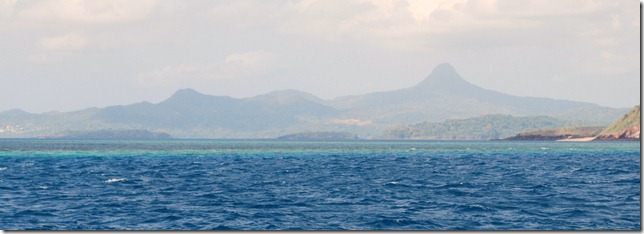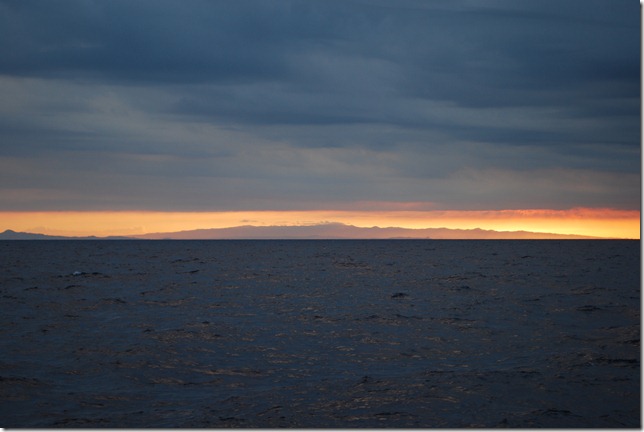Approaching Mayotte was pretty exciting. For the first time in 24 night watches, I had no trouble staying awake until 3 a.m. The wind freshened quite a bit, and in order to avoid putting strain on the rigging, I furled the jib a few times until we were going 4+ knots with just a bit of sail. I could see the glow of civilization on the horizon in the otherwise black night from about 30 miles out, which was quite different from the single point of light that could be seen from Madagascar at night. Then it was time for one last short night of sleep.
By the time I arose, Dallas had already navigated through the large pass into the lagoon. We agreed that the landscape is reminiscent of the Society Islands in French Polynesia. They seem to fit Earl Hinz’ (author of “Landfalls of the Pacific”) definition of an “almost atoll” – the volcanic islands have started to recede into the sea, leaving just the peaks exposed in the midst of the lagoon. Surrounding the lagoon is limestone reef that emerged from the earth’s crust as the volcanoes sank. Here in Mayotte there is one main island (Grand Terre), a smaller one where we are moored (Petite Terre), and a number of very small, uninhabited islands, some of which have beautiful white sand beaches.
The mishaps began when we approached the mooring field. I generally work the bow while Dallas is at the helm, and I had the bridle in place in preparation to anchor. However, the area turned out to be too deep and full of boats for anchoring, so I quickly located our mooring line in the bottom of the sail locker and replaced the bridle set-up. Dallas motored us up to the mooring into the strong wind and swell. I got hold of the buoy with the boat hook but didn’t drag it up and get our line through it fast enough, and before I knew it, the mooring was under the boat with the boat hook attached. The boat hook is pretty important to my work at the bow, so I hopped in the water to retrieve it, swam back to the transom to get on board, and returned to the bow for round two.
This time I was able to pull up the buoy and get our line through, but I put it through a loop of weak rope instead of the thick and sturdy one underneath the large but very heavy buoy. Dallas told me we needed to try again, but I couldn’t get our line free. It was stuck on the buoy. I was afraid the free end of our line was going to end up wrapped around our propeller, which would not make for a good day, so I hopped in the water again! Once in the water, getting the line free was easy, but getting back to the boat in the midst of the strong current was not. Despite the communication problems during this incident (the noise of the wind and the need for quick action made it tough), Dallas decided he wanted to retrieve me and spun the boat around to pick me up. Eventually I made it back on board, and we decided to give it a go again (what choice did we have?!). This time I took the helm, we chose a different buoy, and Dallas was able to pull it up and get us secured to it. Third time’s a charm.
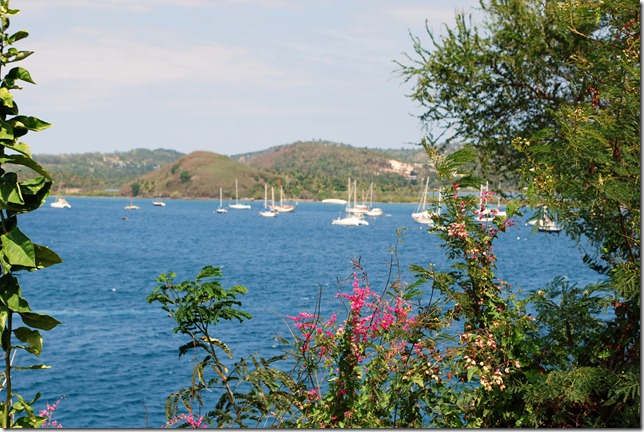 A pretty picture once safely secured on the mooring
A pretty picture once safely secured on the mooring
Speaking of which, I ended up in the water for yet a third time yesterday. It happened that evening after we had returned from taking a walking tour around the island and enjoying some cold beer and pizza. (I guess beer took precedence over salad, although we found a pretty good market and had some salad that evening on the boat.) We had read in other cruisers’ blogs that, at least in 2008, there was quite a bit of crime in Mayotte, and dinghies/outboard engines were commonly stolen. The manager of the yacht club told us it hadn’t happened for a while but suggested that we not stow our outboard behind the boat just in case. We agreed that there’s no point in taking chances with such vital gear, so for the first time ever, we decided to bring it inside the boat at night. With our 15-horsepower, 4-stroke outboard, this is not the easiest of tasks – at least not the first time. We hoisted it up without too much trouble, but in doing so, the cover came off and started floating away. Dallas, who was holding the outboard in place on the boat, shouted, “get it!” So I found myself in the murky water once again. I went through as many clothes yesterday as I did in one week offshore!
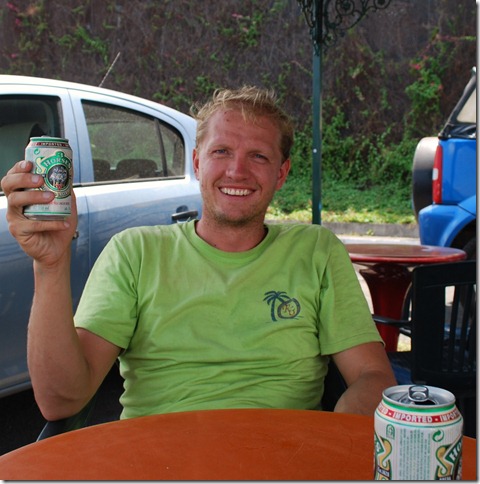 Civilization has its merits such as Three Horses Beer (called “Tay-Hash-Bay”, French for T.H.B.)
Civilization has its merits such as Three Horses Beer (called “Tay-Hash-Bay”, French for T.H.B.)
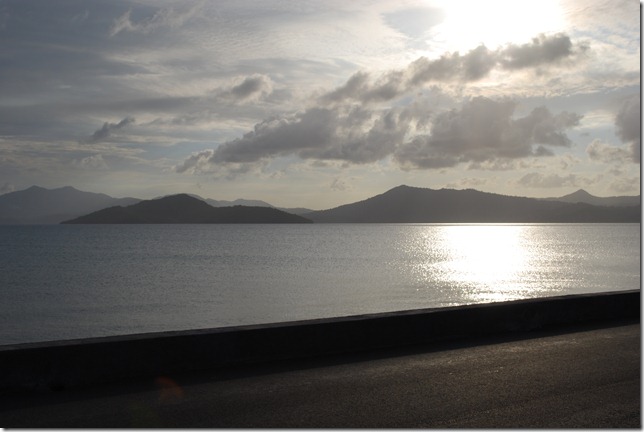 No shortage of natural beauty here either
No shortage of natural beauty here either
Despite the mishaps and potential for crime, it has been a most welcome change to be in the vicinity of land, and a new continent at that! The French presence is very strong here, with French gendarmes (police), French Foreign Legion, and expats visible everywhere we’ve been, but the Mayotte people are still very much African. They are well dressed in colorful sarongs (women) and headwear (men and women) and seem to carry themselves with pride. Some of the women paint their face with an off-white makeup, and I have yet to find out why – just having simple conversations in French has been pretty challenging so far, so we’ll see how it goes!
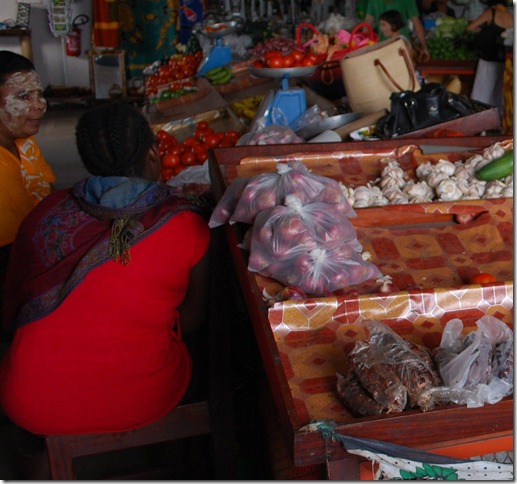 See the face painting – mais pourquoi?!
See the face painting – mais pourquoi?!
It has been pretty full on since we’ve been here – clearing in, getting our bearings, provisioning, taking advantage of internet, etc., but we are going to enjoy some French wine and cheese and a good night’s sleep tonight.
Lat: 12 56.143′ S
Lon: 46 45.511′ E
As Lauren mentioned, sailing by north coast of Madagascar without stopping was tough. Seeing the names of the places we’d read about so close to us on the chartplotter, wanting to meet and trade with the locals, and craving a good night’s sleep left me indecisive until the last minute, but ultimately we decided to sail straight on to Mayotte. At this point, getting out of the cyclone region is our top priority.
Because there are reported to be uncharted reefs on the banks near Madagascar, we’ve kept a course that stays clear of both the near-shore and offshore banks, where depths of over 10,000 feet suddenly rise to 100′ or less. It’s not long after rounding the cape that the tradewinds change direction and then begin to disappear completely, giving way to the light and variable winds that dominate the northeastern part of the Mozambique channel. We also traded the helpful west-setting south equatorial current for a north-setting current that has slowed us down as well. All together, it’s meant that “good” speeds with our damaged rig are now around 3-3.5 knots, making our journey to Mayotte a slow but steady one.
Sunrise yesterday found us still making our way south along the western coastal bank. We were ghosting along at just over 2 knots when the thin strip of eastern sky above the mountains and below the clouds slowly became a glowing, fiery shade of red, casting the mountains as dark silhouettes. The radiant crescent moon hanging above the coastline was still shining brightly as the sky above the clouds began to take on pale shades of blue, grey, and white. Within a few hours we’d dropped below 2 knots under sail, with the wind swinging well forward of the beam. The clear dawn had given way to a hot and hazy morning. It was already hot enough when Lauren woke up that we both climbed down the port swim ladder enjoy a dip in the clear, cool water before starting the engine. “Instant gratification,” was Lauren’s response to immediately feeling cool and refreshed. By noon it was 94 degrees in the salon, about 13 degrees hotter than it was the day before at noon when we were rounding the cape.
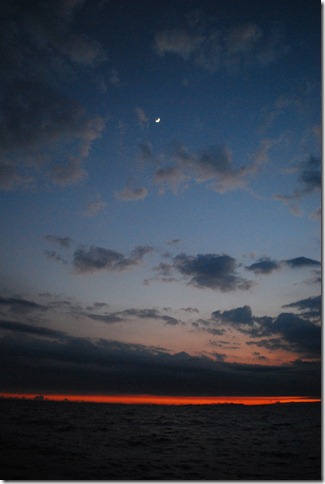 Crescent moon hanging over the fiery red skyline
Crescent moon hanging over the fiery red skyline
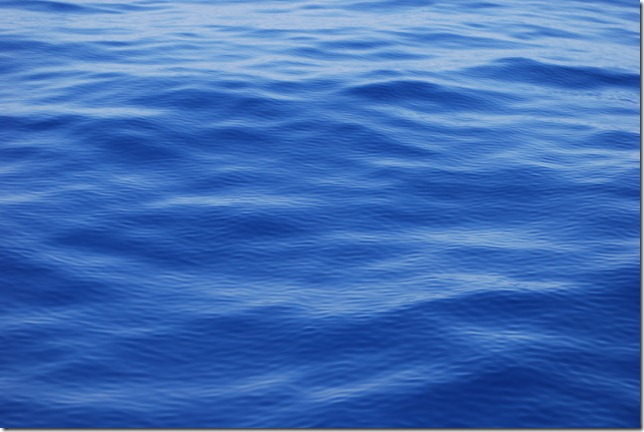 It was as calm as a lake when we jumped in to cool off
It was as calm as a lake when we jumped in to cool off
After an uneventful afternoon of motoring, we got a treat at sunset when I grew a little impatient, changing course early so that we passed just over the southern tip of the Castor Bank as we made for Mayotte, 145 nm due west. As we passed over the bank’s edge, with the sun a glowing ball low in the sky, dolphins started swimming toward us from several directions. At first they seemed docile, and even a little boring, but before long they were breaking the water regularly, while farther away from the boat, several of them made acrobatic leaps and spins, propelling themselves completely clear of the water. In typical fashion, 10 or so swam ahead of and between the bows, playfully jostling each other without ever touching and coming up in groups of two to four for a quick breath before darting back into small, tight, but dynamic formations. It’s been a while since we’ve seen a dolphin show like that, and we thoroughly enjoyed both the show and the timing.
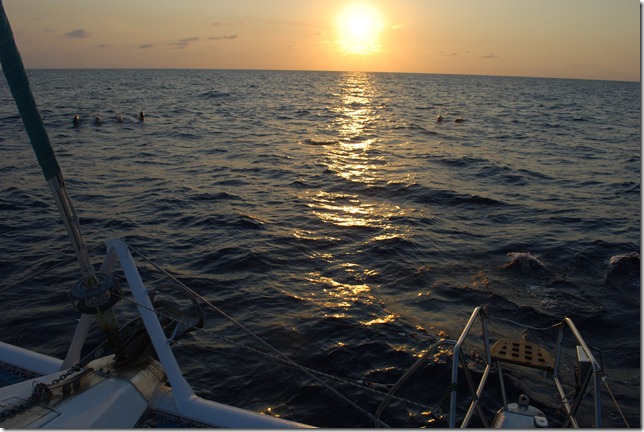 Six dolphins breaking the water as they swim toward us
Six dolphins breaking the water as they swim toward us
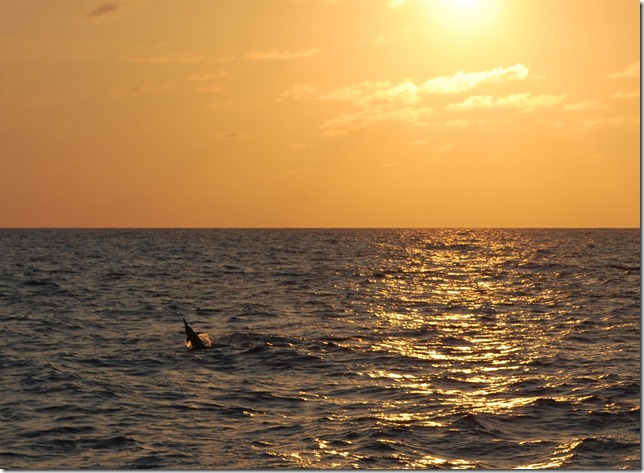 The beginning of a spinning jump
The beginning of a spinning jump
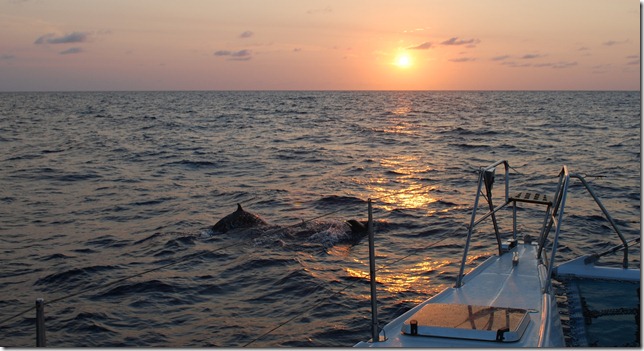 I’m not sure who covered more ground today, but they were probably having more fun
I’m not sure who covered more ground today, but they were probably having more fun
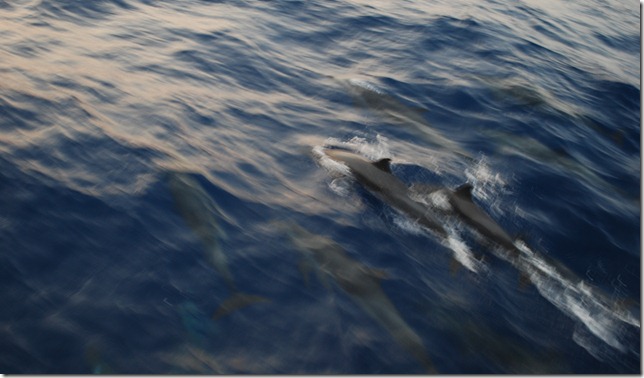 I counted 11 dolphins in the full-size version of this pic
I counted 11 dolphins in the full-size version of this pic
In the twilight, we noticed that the wind had changed again, so we unfurled the jib, this time on a starboard tack as a NNE wind let us sail the rhumb line toward Mayotte. With 90 miles left to go this morning, it’s looking like tomorrow will be the day we finally drop the hook and end our longest passage to date.
Lat: 12 08.785′ S
Long: 48 42.587′ E
Land ho! Dallas was able to see the landscape of Madagascar as soon as the sun came up this morning, at which point we were about 25 miles offshore. I crawled out of bed after 4 1/2 hours of sleep to get a look for myself. The landscape is different than any we have seen before from sea. There are several small but steep mountains with pointy peaks with rolling hills in between. Unlike the lush volcanic islands that we are used to seeing, the land here fits with my vision of the serengetti with its yellow, brown, and red tones. Apparently Madagascar was quite a bit greener in the recent past but was deforested by the residents. It’s hard to imagine.
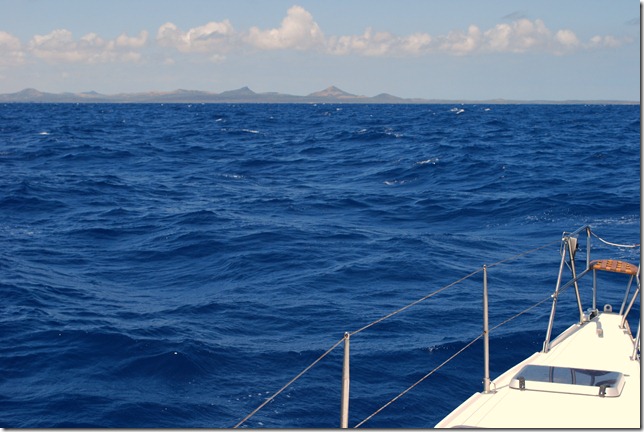 First sight of land in quite some time
First sight of land in quite some time
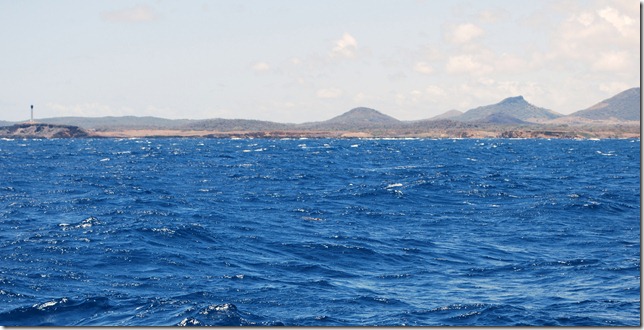
Madagascar was calling my name
After exactly 3 weeks at sea, it was exciting to be in the proximity of land. When approaching a new place, it is always interesting to see the landscape unfold, and there are usually fishing vessels around. Today we haven’t seen a single boat, but a highlight for me was spotting two sea turtles not far from the boat.
With the landscape of Madagascar becoming more and more distant behind us, it would be inaccurate to say that we’ve “made landfall”. It is rewarding to know that we’ve crossed the Indian Ocean but a bit, well, anticlimactic. This is the first time we’ve approached land after an offshore passage without dropping the hook and exploring the place, but we have to cut corners somewhere in order to get out of the way of cyclones ASAP. Up until just a few hours ago, Dallas was still toying with the possibility of spending a few days in Nosy Be on the northwest coast of Madagascar, but after speaking to a rigger in South Africa who has the part we need, it was confirmed that shipping to Mayotte is more reliable, so to Mayotte we will go. Our rigging toggle should be there when we arrive.
Mayotte is only about a two day sail (or motorsail, more likely) from here. I’m sure we can hold out that long. It should be an interesting spot — as a French territory, it is supposed to represent a mix of French and African cultures with a bit of Arab thrown in. My French must be awfully rusty by now, but I know enough to order some croissants and red wine!
Apart from being farther away, my biggest reservation about choosing Mayotte over Madagascar is that, Mayotte being French, it doesn’t represent Africa per se. For example, the wages and standard of living in Mayotte are comparable to those of Europe, whereas Madagascar is one of the poorest countries in the world. However, we should have a chance to see the impoverished side of Africa and distribute our balls, clothes, etc. while we are coastal hopping along Mozambique.
We pulled in a barracuda about an hour ago, so I’m going to cook up a small piece for dinner. I would like to have a big piece, but since we caught it in an area where there are reefs, there’s a chance that it might have ciguatera toxins, so I’m going to sample a bit and see what happens as suggested by our fishing handbook. Symptoms (in minor cases) include tingling lips, nausea, and vomiting, so hopefully my craving for fresh fish won’t come back to bite me!
Lat: 12 18.340′ S
Lon: 52 43.530′ E
We aren’t exactly screaming along with half a jib, but we’re managing to average about 100 nm daily, and everything is holding together. That speed has us sighting land in two days! Unfortunately, we’re probably going to sail right by the land we sight.
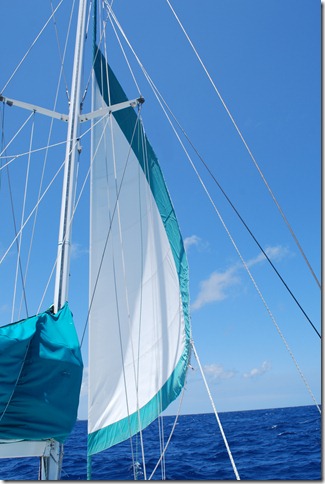 Even partially furled, the workhorse keeps moving us along
Even partially furled, the workhorse keeps moving us along
The spare part hasn’t been ordered yet, but with the repair holding together, it’s looking more like we’ll head for Mayotte if the piracy situation doesn’t look too bad. We were really looking forward to seeing the Nosy Be area of Madagascar, but with the cyclone season officially starting tomorrow, we need to keep moving. Mayotte, a French possession in the northern part of the Mozambique channel, is only two extra days of sailing and looks like a much, much better place to ship parts. We can take on good quality, duty-free diesel, fill our water tanks, find western groceries (though they’ll be expensive), and best of all, have the part shipped in without taking weeks to clear customs and having to endure the risk of “complications and delays”.
The weather has been beautiful since we had the rigging failure, which has been a real blessing. The sunny skies, moderate winds, and relatively light seas have made the slower pace easier to deal with and given us less cause to worry about the jury-rigged repair.
Listening to Bob on Boomerang describe conditions nearing Richards Bay, South Africa, has been a sobering reminder of how treacherous the area can be. A few days ago he was at sea in the Mozambique channel current for a SW “buster” that blew about 25 knots against the current and created steep, close, 16-18-foot seas. A couple days later a small coastal low turned intense and he was hammered with 40 knots of sustained wind and seas that towered over the boat, all the while trying to dodge shipping traffic coming in and out of the busy port. His response on the morning net as to how things were going was simple: “Not good.” We’re hoping our plan to hug the Mozambique coast will give us the chance to be at anchor during those types of blows, but it’s certainly no place to sail with rigging problems, so we’ll be waiting at the north end of the Mozambique Channel until we can get and install a new part.
Lat: 12 32.030′ S
Long: 055 51.888′ E
Less than 400 miles to go to the Cape! We are finally closing in on it. Dallas’ rigging repair seems to be holding up very well, which has been a huge relief. It was so nice to start sailing again after two and a half straight days of motoring, and we really couldn’t ask for better weather. The seas are calm, the wind is fair, the sky is blue, and at the moment we are in a current that is pushing us right along. We are going 5 knots using only half of the jib (so that we don’t put too much strain on the rigging).
Despite the idyllic conditions, I’m no longer feeling as though I could stay out here indefinitely. I’m ready to be there yesterday! Just kidding. I’m not desperate (yet), but I am really looking forward to going to bed well before 3 a.m., having some new scenery to explore and people to meet, and of course, eating some food I didn’t prepare accompanied by a nice, cold beer or a glass of wine.
Dallas asked me what I would rather have when we go ashore: a cold beer or a salad. I told him that it depends on the salad and the beer. I would almost certainly opt for a greek salad with chicken over a can of Bud Lite, but given a choice between a garden salad and a pint of good lager — that’s a no-brainer. However, I did dream about salad, and to my knowledge, I haven’t dreamt about beer!
Being on passage tends to make for some interesting dreams. We were discussing this with some other cruisers in Cocos and deduced that it is because sleep is more disturbed by the noise, movement, etc., so you wake up and remember dreams more frequently. I think another reason for it might relate to the function of dreams. Typically, dreams are thought to be our mind’s way of consolidating information that was processed throughout the day, but in the case of being offshore for 2 1/2 weeks, there’s not a whole lot of new info coming in. For me anyway, it seems like the mind responds by cycling through old material. I have dreamt about people and places that I haven’t thought of for many years. It’s like being on a garbled and disjointed version of “This is Your Life”. Or maybe this is what it’s like to be in a sensory deprivation chamber. People pay good money for this!
In our waking hours, Dallas and I are both reading up on Africa. I’m reading Nelson Mandela’s autobiography, “Long Walk to Freedom”. Of course it’s an amazing story about the ability of a group to affect change (stop apartheid) through sheer determination and devotion to their cause. It also led me to realize just how Africa-ignorant I am. For example, I’d never heard of the Xhosa nation of which Mandela is a member, and reading about their customs gave me new appreciation for what makes African culture unique, at least by Western standards. For example, as a child psychologist, I found it interesting to read that Xhosa children are expected to learn through observation and imitation. Asking adults questions is considered impertinent and probably will not result in a response. I can see how this could foster respect for elders but think it might backfire when used with more inquisitive types who need to know “WHY?”.
Right now I want to know why the fish aren’t biting. Dallas rigged up two new lures with in-line bungees to absorb the shock of the hit on the other end, but we’re trolling both to no avail. The fish aren’t even responding to my shouts….like I said, time to get off the boat!


